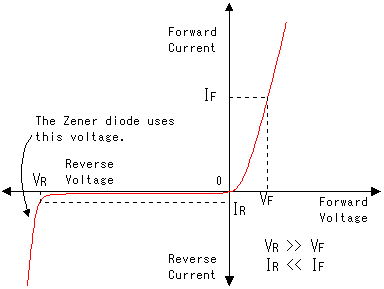We Aim To Creat Value For All Customers, And Provide Good-quality
And Good-price Products For All Customers
We Aim To Creat Value For All Customers, And Provide Good-quality
And Good-price Products For All Customers

A diode is a semiconductor device which allows current to flow through it in only one direction. Although a transistor is also a semiconductor device, it does not operate the way a diode does. A diode is specifically made to allow current to flow through it in only one direction.
Some ways in which the diode can be used are listed here.
![]() A diode can be used as a rectifier that converts AC (Alternating Current) to DC (Direct Current) for a power supply device.
A diode can be used as a rectifier that converts AC (Alternating Current) to DC (Direct Current) for a power supply device.
![]() Diodes can be used to separate the signal from radio frequencies.
Diodes can be used to separate the signal from radio frequencies.
![]() Diodes can be used as an on/off switch that controls current.
Diodes can be used as an on/off switch that controls current.
This symbol ![]() is used to indicate a diode in a circuit diagram.
is used to indicate a diode in a circuit diagram.

The meaning of the symbol is (Anode)![]() (Cathode).
(Cathode).
Current flows from the anode side to the cathode side.
Although all diodes operate with the same general principle, there are different types suited to different applications. For example, the following devices are best used for the applications noted.
| | Voltage regulation diode (Zener Diode) The circuit symbol is It is used to regulate voltage, by taking advantage of the fact that Zener diodes tend to stabilize at a certain voltage when that voltage is applied in the opposite direction. |
| | Light emitting diode The circuit symbol is This type of diode emits light when current flows through it in the forward direction. (Forward biased.) |
| | Variable capacitance diode The circuit symbol is The current does not flow when applying the voltage of the opposite direction to the diode. In this condition, the diode has a capacitance like the capacitor. It is a very small capacitance. The capacitance of the diode changes when changing voltage. With the change of this capacitance, the frequency of the oscillator can be changed. |

The graph on the right shows the electrical characteristics of a typical diode.
When a small voltage is applied to the diode in the forward direction, current flows easily.
Because the diode has a certain amount of resistance, the voltage will drop slightly as current flows through the diode. A typical diode causes a voltage drop of about 0.6 - 1V (VF) (In the case of silicon diode, almost 0.6V)
This voltage drop needs to be taken into consideration in a circuit which uses many diodes in series. Also, the amount of current passing through the diodes must be considered.
When voltage is applied in the reverse direction through a diode, the diode will have a great resistance to current flow.
Different diodes have different characteristics when reverse-biased. A given diode should be selected depending on how it will be used in the circuit.
The current that will flow through a diode biased in the reverse direction will vary from several mA to just A, which is very small.
The limiting voltages and currents permissible must be considered on a case by case basis. For example, when using diodes for rectification, part of the time they will be required to withstand a reverse voltage. If the diodes are not chosen carefully, they will break down.
![]() Rectification / Switching / Regulation Diode
Rectification / Switching / Regulation Diode


The stripe stamped on one end of the diode shows indicates the polarity of the diode.
The stripe shows the cathode side.
<span style="font-family:
